托福听力lecture主要话题分类精讲
- 格式:doc
- 大小:41.50 KB
- 文档页数:16
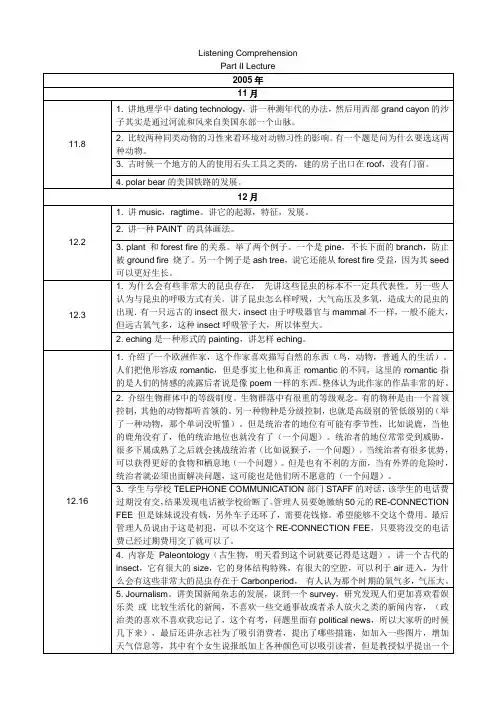
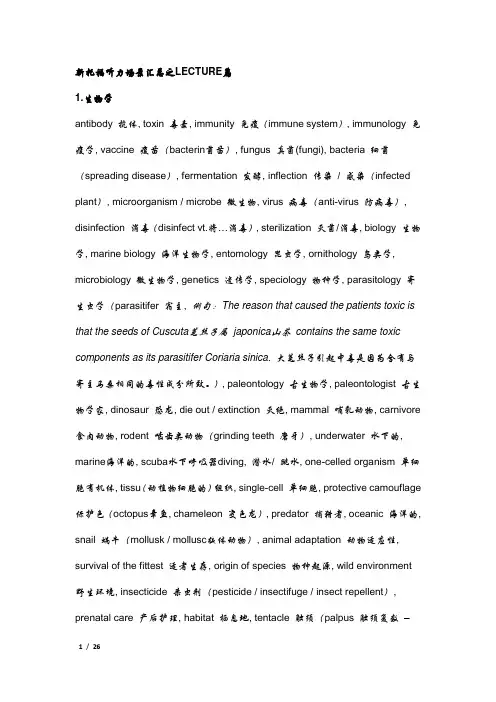
新托福听力场景汇总之LECTURE篇1.生物学antibody 抗体, toxin 毒素, immunity 免疫(immune system), immunology 免疫学, vaccine 疫苗(bacterin菌苗), fungus 真菌(fungi), bacteria 细菌(spreading disease), fermentation 发酵, inflection 传染/ 感染(infected plant), microorganism / microbe 微生物, virus 病毒(anti-virus 防病毒), disinfection 消毒(disinfect vt.将…消毒), sterilization 灭菌/消毒, biology 生物学, marine biology 海洋生物学, entomology 昆虫学, ornithology 鸟类学, microbiology 微生物学, genetics 遗传学, speciology 物种学, parasitology 寄生虫学(parasitifer 宿主, 例句:The reason that caused the patients toxic is that the seeds of Cuscuta菟丝子属japonica山茶contains the same toxic components as its parasitifer Coriaria sinica. 大菟丝子引起中毒是因为含有与寄主马桑相同的毒性成分所致。
), paleontology 古生物学, paleontologist 古生物学家, dinosaur 恐龙, die out / extinction 灭绝, mammal 哺乳动物, carnivore 食肉动物, rodent 啮齿类动物(grinding teeth 磨牙), underwater 水下的, marine海洋的, scuba水下呼吸器diving, 潜水/ 跳水, one-celled organism 单细胞有机体, tissu(动植物细胞的)组织, single-cell 单细胞, protective camouflage 保护色(octopus章鱼, chameleon 变色龙), predator 捕猎者, oceanic 海洋的, snail 蜗牛(mollusk / mollusc软体动物), animal adaptation 动物适应性, survival of the fittest 适者生存, origin of species 物种起源, wild environment 野生环境, insecticide 杀虫剂(pesticide / insectifuge / insect repellent), prenatal care 产后护理, habitat 栖息地, tentacle 触须(palpus 触须复数–palp 单数, tentaculum (tentacula pl.), whisker胡须), prey 捕食, navigate 导航, receptor 接收器, nerve 神经, specimen 物种, amphibian 两栖类动物(frog, toad / bufonid 蟾蜍, giant salamander大鲵俗称娃娃鱼), decline in the number 数量减少, gene 基因, genetic 基因的,遗传的, endangered species 濒危动物(extinct species), survival 活着的, transition 转变/过渡, microbe 微生物, yeast 酵母(菌), catalyst 催化剂, reptile 爬行类动物(lizard蜥蜴, snake, turtle 龟, soft-shelled turtle 鳖, crocodile 鳄鱼, chameleon 变色龙, gecko 壁虎), hatch 孵化/ incubation 孵化, (Don’t count your chickens before they are hatched.切莫过于乐观) nest 巢, offspring 子孙, chew up 咀嚼, unfertilized eggs 未受精卵, nutrient 营养品, nutrition 营养, nutrilite 营养物,微量营养物, nourishment 营养品/ 食物, feed 喂养, cannibalism 同类相食, respiration 呼吸, ingestion 摄食, digestion 消化, digestive enzyme 消化酶, cell 细胞, nucleus 细胞核, cytoplasm 细胞质, plasma lemma / cell membrane 细胞膜, cell wall 细胞壁, protein 蛋白质, amino acid 氨基酸, plankton 浮游生物, heredity 遗传(inheritance 遗传,继承, inherit v.), mutation of species 物种变异, mutation 变种, chromosome 染色体, genetic engineering 遗传工程, solitary 独居, social 群居, swamp 沼泽地、湿地, bio-diversity 生物多样性, metamorphosis 变态/变形, variation 变异, blight 枯萎, soil-borne 土壤产生的, host plant 寄主植物, parasitifer 宿主植物2. 动物学zoology 动物学, Darwinism 达尔文学说, natural selection 自然选择, phylum 门, class 纲, order 目, sub-order 亚目, family 科, genus 属, species 种,invertebrate 无脊椎动物, vertebrate 脊椎动物, aquatic life 水生动物, reptile爬行动物, amphibian/amphibious animal 两栖动物, protozoa 原生动物, rodent 啮齿动物, ruminant 反刍动物, parasitic animal 寄生动物, primate 灵长动物, plankton 浮游生物, mollusk 软体动物, coelenterate 腔肠动物(如水母jellyfish、海蜇、珊瑚coral等), herbivore 食草动物, carnivore 食肉动物, mammal 哺乳动物, homotherm 恒温动物又称为温血动物(鸟类birds:ostrich 鸵鸟, penguin 企鹅, stork 鹳, chick / chicken, duck, eagle / halk 鹰, crane 鹤, sea gull 鸥, parrot 鹦鹉, cuckoo 杜鹃, night owl 猫头鹰, sparrow 麻雀;哺乳动物mammal:kangaroo 袋鼠, hedgehog 刺猬, bat, rabbit, mouse / rat, cat, dog, whale, panda, seal 海豹, ox / cow / cattle, horse, sheep, pig, monkey, human)poikilotherm 变温动物又称cold-blooded animal 冷血动物(snake earthworm 蚯蚓, frog青蛙, giant salamander 大鲵, fishes 鱼, chameleon 变色龙), scavenger 食腐动物, carnivorous 食肉的, herbivorous 食草的, omnivorous杂食的, camouflage 伪装, hibernate 冬眠/ 蛰伏, regeneration 再生, predatory adj. / carnivore 食肉的, predator 捕食者, prey 捕食, hordes / swarms(昆虫等)群, flock(牛、羊等)群, community 动物的群落或人的部落, population 种群, herd 兽群, hygiene 卫生(food hygiene), sanitation 公共卫生、卫生设施, monogamous 一夫一妻的/一雌一雄的, polygamous 一夫多妻的/一雄多雌的, polyandrous 一妻多夫的/一雌多雄的, nomadic 游牧的;流浪的, trapper 诱捕动物者, niche 小生态环境, vestige退化器, fertilizer 受精媒介物, metabolism 新陈代谢, breed(名词)品种;(动词)繁殖, multiply / reproduce繁殖, spawn(鱼、虾、蛙等)孵, anatomy 解剖学, appetite 食欲, creature 生物, scales 鳞, feathers 羽毛, armor 甲spinal cord 脊椎, digestive duct 消化管, esophagus 食管, stomach 胃, small intestine 小肠, large intestine 大肠, anus 肛门, digestive gland 消化腺, salivary gland唾液腺, liver 肝, gallbladder 胆, bladder 膀胱, pancreas 胰人体九大系统:digestive system 消化系统, excretory system 排泄系统, reproductive system 生殖系统, circulatory system 循环系统, respiratory system 呼吸系统, hormonal system 内分泌系统, urinary system 泌尿系统, immune system 免疫系统, nerve system 神经系统squirrel 松鼠, marten 貂, bat 蝙蝠, squeak(老鼠等)吱吱, otter 水獭, antelope 羚羊, gorilla 大猩猩, chimpanzee 黑猩猩, baboon 狒狒, hyena 鬣狗, beaver 海狸, moose 驼鹿, elk 麋鹿, reindeer 驯鹿, giraffe 长颈鹿, rhinoceros 犀牛, hippo 河马, sloth 树懒, slothful 懒惰的, frog 青蛙, tadpole 蝌蚪, salamander 蝾螈/ 大鲵, scorpion 蝎子, turtle 龟, lizard 蜥蜴, chameleon 变色龙, caymen / crocodile 鳄鱼, centipede 蜈蚣, robin 知更鸟, owl 猫头鹰, barnacle 北极鹅, canary 金丝雀(canary wharf 伦敦金丝雀码头), chirp(鸟、虫的叫声), vulture 秃鹫, ptarmigan 雷鸟, migrate 迁移, plumage 羽体, wing 翅膀, bill 鸟嘴, beak(鹰等的)嘴, insect 昆虫, wasp 黄蜂, hornet 大黄蜂, spider 蜘蛛, pest 害虫, worm 虫/蠕虫, cicada 蝉, mantis 螳螂, cockroach 蟑螂, antenna / tentacle 触须, larva 幼虫, mating ritual 求偶仪式, preen 洋洋得意, groom 打扮, inhibit 抑制、禁止, disinhibition抑制, displacement 取代,3. 海洋生物学jellyfish 水母, nettlefish 海蜇, coral 珊瑚, dolphin 海豚, whale 鲸鱼, shrimp 小虾, prawn 对虾, lobster 龙虾, crab螃蟹, mussel 贻贝;蚌类, clam 蛤蜊, oyster 牡蛎, sponge 海绵, starfish 海星, squid 鱿鱼;乌贼, octopus章鱼, sole 鳎;鳎目鱼, plaice / flatfish 鲽,红斑比目鱼(flounder)4. 植物学botany 植物学, botanical / botanic 植物学的, horticulture 园艺学, aquatic plant 水生植物, parasite plant寄生植物, root 根, canopy 树冠层/顶棚, foliage / leaf 叶, leaflet 小叶, rosette(叶的)丛生, stem 茎, stalk杆, leafstalk 叶柄, shoot / sprout 嫩芽/抽枝, flower 花, bud 花蕾, petal 花瓣, peel / skin 果皮, shell(硬)果壳husk(干)果壳/(玉米)苞叶, trunk 树干, bark 树皮, branch 树枝, bough 大或者粗的树枝, twig 小树枝, jungle丛林, lawn 草坪, meadow 草地/牧场, prairie 大草原, mosses 苔藓, shrub / bush 灌木, cluster 一簇(灌木), fern 蕨类植物, horsetails 木贼类植物, club mosses 石松类植物, herb 草, photosynthesis光合作用, chlorophyll 叶绿素symbiosis 共生, symbiotic 共生的, wither / shrivel / fade 凋谢, blossom 花, pollen 花粉, pollinate 传授花粉, petal 花瓣, nectar 花蜜, tissue 组织, organ 器官, system 系统, seeds种子, everlasting永久的, crossbreed 杂交, root pressure 根压, bore 腔/肠, cohesion-tension 凝聚压力, column 花柱, necrosis坏死, barren 贫瘠的;不生育的, futile 无用的, carbohydrate (starch) 碳水化合物(淀粉), glucose 葡萄糖, starch 淀粉, fat 脂肪, protein 蛋白质, vitamin 维他命, mal nourish ed 营养不良的(mal-不好, 坏的), nutrition 营养, perennial 多年生的, annual 一年一生的, verdant 绿油油的,嫩绿的,翠绿的, evergreen 常青树, conifer tree 针叶树, larch 落叶松, pine 松树, spruce 云杉, juniper 刺柏;杜松, sequoia 红杉, elm 榆树, walnut 核桃树, redwood 红木树, plum blossom 梅花, orchid 兰花, chrysanthemum 菊花, water lily 荷花/莲花, rhododendron杜鹃花, rose 玫瑰, carnation 康乃馨, lily 百合, jasmine 茉莉花, helianthus / heliotrope / sunflower 向日葵, camellia 茶花, corn / maize / mealie 玉米, pumpkin 南瓜, tomato 番茄, lettuce 莴苣, cabbage 卷心菜, wheat 小麦, rye 黑麦, barley 大麦, oats燕麦, germinate (使)发芽, 生长, remnant 剩余/ remains 剩余, dwindle 减少/ decline / decrease / dip5. 气象学meteorology 气象, meteorologist 气象学家, meteorological station 气象站, forecast / predict 预报, climate 气候, atmosphere 大气层, troposphere 对流层, stratosphere 平流层, mesosphere 中间层, ionosphere 电离层, exosphere 逸散层, cold front 冷锋, warm air mass 热气团current(气)流moisture 潮湿,水气spell某种天气持续一段时间, vapor 蒸汽, evaporate 蒸发, damp / moist / humid 潮湿, humidity 湿度, moisture 潮湿/ 水分, saturate 饱和, dew 露, frost 霜, fog / mist 雾, smog 烟雾, droplet 小水, condense 浓缩, crystal水晶体, sheet(水、冰、雪的)一层, downpour / torrential rain 大雨, tempest (storm) / torrential rain 暴风雨, drizzle 细雨, shower 阵雨, hail 冰雹, blizzard / snowstorm 暴风雪, avalanche / snow slide 雪崩, precipitation(雨、露、雪等)降水, thunder 雷, breeze 微风, sandstorm 沙暴, monsoon 季风, gale 大风whirlwind 旋风typhoon 台风, hurricane 飓风, tornado / twister / cyclone 龙卷风, wind scale 风级, tsunami / seismic sea wave 海啸, tidal wave 潮汐;浪潮,upper atmosphere 上层大气, funnel 漏斗云, disaster / calamity /catastrophe灾难, devastation 破坏submerge 淹没drought 旱灾convection 对流wind velocity 风速, wind direction 风向, long-range forecast 长期预报, numerical weather prediction 数值天气预报, nephanalysis 云层分析;卫星云图6. 地质学crust 地壳, mantle 地幔, core 地核, continental crust大陆地壳, oceanic crust 海洋地壳, layer / stratum 地层, stratigraphy 地层学, fault 断层, fault plane 断层面, fault zone 断层带, rift / crack / split 断裂, disintegration /decomposition 分解, erosion 腐蚀, fossil 化石, igneous rock 火成岩, sedimentary rock 沉积岩, metamorphic rock 变质岩, limestone 石灰岩, granite 花岗岩, marble 大理石, lithosphere 岩石圈, magma / molten lava 岩浆, quartz 石英, mineral 矿物, ore 矿石, deposit 矿床, rubble 碎石, debris 残骸, platinum 白金/ 铂金, silver 银, copper 黄铜, aluminum 铝tin 锡, lead 铅, zinc 锌, nickel 镍, mercury 汞/水银, sodium 钠, gem 宝石diamond 钻石, emerald 绿宝石, ruby 红宝石, glacier 冰川glacial 冰川的, glacial epoch / age / period 冰川期, glacial drift 冰渍, moraines 冰碛, iceberg 冰山volcano 火山, active volcano 活火山, extinct volcano 死火山, dormant volcano 休眠火山, (sloping) shield volcano 盾状火山(平缓), (steep-sided) cone volcano 锥状火山(陡峭), eruption 火山喷发, crater 火山口, caldera (开口较大的)火山口, depression 洼地,凹陷处;盆地, lava 火山岩浆, volcanic dust 火山尘, volcanic ash 火山灰, geyser 间歇喷泉, hot spring 温泉, earthquake / quake / tremor / seism 地震, seismic 地震的, seismology 地震学, magnitude 震级, seismic intensity scale 震烈度, seismicwave 地震波, transverse wave 横波, longitudinal wave 纵波, epicenter 震中, epicentral distance 震中距, aftershock 余震cataclysm 灾变, tsunami / tidal / force 海啸, undersea landslide 海底山崩, melt global warming 全球逐渐变暖, aquifer 蓄水层, swamp 沼泽, peat bog 泥炭沼泽, Great Canyon 大峡谷, Nile River 尼罗河, Colorado river 科罗拉多河, crumples zones 地质缓冲地带, bedrock 岩床, bulge 凸起物7. 考古学archaeology 考古学, paleontology 古生物学, anthropolog 人类学, archaeologist 人类学家, pale-anthropologist古人类学家, ecological anthropologist 生态人类学家, psychological anthropologist 心理人类学家, originate起源于, ancestor 祖先hominid 人(科), homogeneous 同以种族(种类)的tribe 部落, clan 氏族, excavation 挖掘, excavate / unearth 挖掘, ruins 遗迹/废墟, remains 遗产/遗骸artifact 手工艺品, relic 遗物/文物, antique 古物/古董, antiquity 古代/古老, Stone Age 石器时代, Bronze Age 青铜器时代, Iron Age 铁器时代, Paleolithic 旧石器时代的, Mesolithic 中石器时代的, Neolithic 新石器时代的, morphology 形态学, skull 颅骨, cranial 颅骨的, fossil 化石, ancient civilization 古代文明, cave man 山顶洞人cultural relics 文物, rock painting 岩画8. 地理学hemisphere 半球, meridian 子午线/ 经线, parallel 平行圈, latitude 纬线, longitude 经线/ 经度, elevation 海拔, altitude 高度/ 海拔, horizon 地平线, equator 赤道, temperature latitudes 温带地区, tropics 热带地区, Arctic / theNorth Pole 北极, Antarctic / Antarctica 南极, the Antarctic Continent南极洲, the Antarctic Circle南极圈, the Arctic Circle 北极圈, aurora 极光, tropics of Cancer 北回归线, tropics of Capricorn 南回归线, international date line 国际日期变更线, time difference 时差, time zone 时区, topography 地形/ 地形学plain 平原plateau / highland 高地, lowland 低地, basin 盆地, oasis 绿洲, enclave 飞地, peak 山峰, cordillera /ranges 山脉, carven / cave 洞穴, terrain 地域, subterranean 地底下, coastland 沿海地区, coastline 海岸线, watershed 分水岭, upper reaches 上游, lower reaches 下游, tributary 支流, deposit 沉积, spring / fountain 泉水, iceberg 冰山, riverbed 河床, gulf / bay 海湾, waterfall 瀑布, cascade 小瀑布;喷流reef 暗礁, tide 湖水, torrent 水的急流, tropical rain forest 热带雨林, continental island 大陆岛, volcanic island 火山岛, coral island 珊瑚岛, islet 小岛, peninsular 半岛, archipelago 群岛, delta 三角洲landlocked area 内陆inland waterway 内陆河subcontinent次大陆cliff 山崖, valley 山谷, hillside / mountain slope 山坡, continental shelf 大陆架, canyon / gorge 峡谷, channel / strait 海峡, remote-sensing 遥感的, terrestrial 地球的/ 陆地的, terrestrial heat / geothermal 地热, terrestrial magnetism 地磁, continental drift 大陆漂移学, sea-floor spreading 海床扩展, evaporation 蒸发salinity 含盐度, ocean bottom 海床, sediment 沉积物, tropical 热带的, temperate温带的, frigid 寒带的, frost heaving 冻胀现象, tundra 苔原,冻原, fieldstone 卵石the Mediterranean Sea 地中海, the primeval forest 原始森林, Scandinavia 斯堪的纳维亚(半岛)(瑞典、挪威、丹麦、冰岛的泛称)fjord峡湾, coral reef 珊瑚礁, Chalk 白垩纪, cataclysm 大洪水, ridge 山脊;分水岭, abyss 深渊, territory 版图;领土地域, Pyrenees 比利牛斯山脉, Carpathians 喀尔巴阡山脉, Vesuvius 维苏威火山, Pompeii 庞贝, precipice悬崖, eon 世;纪;代, glacier 冰河, Pangaea 盘古大陆, dune 沙丘, Lagoon 咸水湖9. 天文学astronomy 天文学, astronomical observatory 天文台, planetarium 天文馆, astrophysics 天文物理学, astrology 占星学, pseudoscience 伪科学, cosmos / universe 宇宙, cosmology 宇宙, infinite 无限的, cosmic 宇宙的, cosmic radiation 宇宙辐射, cosmic rays 宇宙射线, celestial 天体的, celestial body / heavenly body 天体, celestial map / sky atlas 天体图, celestial sphere 天球, dwarf / dwarf star 矮星, quasar 类星体, constellation 星座, galaxy / Milky Way 银河系, star cluster 星团, asterism 星群, solar system 太阳系, solar corona 日, 冕solar eclipse 日食, solar radiation 太阳辐射, planet 行星, planetoid / asteroid小行星, revolve 旋转, twinkle 闪烁, naked eye 肉眼, Mercury 水星Venus 金星, Earth 地球, Mars 火星, Jupiter 木星, Saturn 土星, Uranus 天王星, Neptune 海王星, Pluto 冥王星, orbit 轨道, spin 旋转, satellite卫星, lunar 月球的, meteor 流星, meteor shower 流星雨, star 恒星, meteoroid 流星体, meteorite 陨石, comet 彗星, space / outer space 太空,外层空间, spacecraft / spaceship 宇宙飞船, space shuttle 航天飞机, space telescope 空间望远镜, astronaut / spaceman 宇航员, space suit 宇航服, stellar 恒星的, intergalactic 星系间的, interstellar 恒星间的, interplanetary 行星间的asteroid 小行星nebula 星云space debris太空垃圾ammonia 氨, photosphere 光球;光球层chromospheres 色球;色球层日冕层, sunspot 太阳黑子(发生在光球层), flare 耀斑(发生在色球层), solar prominence 日珥(发生在色球层), convection zone 对流层, vacuum 真空, infrared ray 红外线, absolute magnitude 绝对量级, emission 发射/散发, high-resolution 高清晰度, interferometer 干扰仪,干涉仪, illusive object 幻影体, faint 微弱的, image影像, gravitational force 吸引力, molten 融化的, leap year 闰年, rotation 自传, revolution 公转, black hole 黑洞, ultraviolet ray 紫外线luminosity 光度, light year 光年10.环保相关ecology 生态学, ecosystem 生态系统, balance of nature 自然界生态平衡, fauna 动物群, flora 植物群, rainforest 雨林, food chain 食物链, acid rain 酸雨, greenhouse 温室效应, infrared radiation 红外线辐射, ozone layer / ozonosphere 臭氧层, ultraviolet radiation 紫外辐射, pollution control 污染控制, air pollution 空气控制, water pollution 水污染, noxious / toxic 有毒的, fumes(有毒的)废气, waste 废物, solid waste 固体废物, sewage / wastewater 污水, sewage purification 污水净化, swage disposal 污水处理, decibel(噪音)分贝11. 能源相关fossil fuel 矿物燃料, process of photosynthesis 光合作用, solar energy 太阳能, nonrenewable 不可再生的, energy conservation 保护能源, resource 资源, energy source 能源资源, tidal energy潮汐能, fuel-efficient 节能型的, rush hour 高峰期, zero emission 零辐射, wildness 野生/天然, preservation 保护, atmosphere 大气, carbon 碳, dioxide 二氧化物, burning of coal and oil 煤油燃烧, global warming 全球变暖, greenhouse effect温室效应, rise in sea level 海平面上升, long-term climatic change 长期的气候变化, environmental recycling center 再循环利用中心, litter/trash garbage 垃圾, pollutant 污染物, desertification 沙漠化deforest 滥伐森林, drought 干旱, water shortage 水源缺乏, offshore spillage 近海岸溢出, carbon dioxide release 二氧化碳排放, industrial sewage 工业污水, recycling 再循环, purify 净化, deteriorate 恶化, acid rain 酸雨, sewage disposal 污水处理, environment protection 环境保护, ozone layer 臭氧层, waste disposal 废物处理, emission(汽车废气的)排放, soot 烟尘, El Niño 厄尔尼诺现象12.新技术发明相关13.人类学artist 艺术家, choreographer 舞蹈编排家, critic 批评家, satirist 讽刺作家, inventor 发明家, biographer 自传作家, sculptor 雕塑家, feminist 女权主义者, humanitarian 人道主义者, imagist 意象派诗人, philanthropist 慈善家, proprietor 业主, mortal 犯人precursor 先驱, figurehead 名誉领袖, disciple 学徒, apprentice 学徒, mechanic 机械工, minimalist 简单抽象派艺术家,avant-garde 前卫派, territory 领域, genre 风格/体裁, eccentric古怪的, odd 怪诞的/奇数的, erratic 奇怪的, weird 怪异的/不可思议的, romantic 浪漫的, innocent 天真的/无罪的, lovelorn 相思病苦的, emotional 情绪的/情感的, sentimental 感伤的/多愁善感的, cheerless 无精打采的/无生命力的, patriarchal 家长的/ 族长的, rigid 僵化的, spare 简朴的, clumsy 笨拙的, zigzag 曲折的, contemporary 当代的, acclaimed 受欢迎的, preeminent 杰出的, versatile(人)多才多艺的/(物)多功能的, household 家庭的/家喻户晓的, genuine 真正的, authentic 逼真的/原汁原味的, symbolic 象征性的, immortal 不朽的/神nostalgia 怀旧主义/思乡, emotive 感人的, prodigious 巨大的, classic 经典的, posthumous 死后的14.发展史文学pose 散文diary 日记, autobiography 传记, editorial 社论, narrative prose 叙述性, descriptive prose 描写性, essay 随笔, poetry诗歌, ballad 民谣, lullaby 催眠曲, fiction 小说allegory 寓言, fairy tale 童话, legend 传说, proverb 谚语, model 人物原型, leading character 主人公, main plot 主要情节, prelude 序曲, prologue 序言, epilogue 尾声, literary criticism 文学批评, literary studies 文学研究, schools of literature 文学流派, comparative literature 比较文学, realism 现实主义, surrealism 超现实主义, futurism 未来主义, modernism 现代主义, aestheticism 唯美主义音乐musical instrument 乐器, orchestra(管弦)乐队, shook rattle 摇拨浪鼓, pound dru 击鼓, foot beat 跺脚, note音符, score 乐谱, movement 乐章, fanatical狂热的, hillbilly music 乡村音乐, folk music 民间音乐, pop music 流行音乐, classical music 古典音乐, Jazz 爵士乐symphony 交响乐rock and roll 摇滚乐band music / wind music 管乐, string 弦乐, violin 小提琴, viola 中提琴, cello 大提琴, harp 竖琴, horn 号;喇叭, clarinet单簧管, oboe 双簧管, keyboard instrument 键盘乐器, percussion 震荡/打击乐器, vocal music 声乐, concerto协奏曲, sonata 奏鸣曲, serenade 小夜曲, solo 独奏/ 独唱, duet 二重唱, conducting 指挥, podium 指挥台, accompaniment 伴奏, quality 音质, volume 音量, chord 和弦, harmony 和声, rest 休止, time 节拍, lullaby 催眠曲, prelude 序曲, epilogue 尾声政治经济subsistence 存活,生活subsistence wage 刚够养家糊口的工资, subsistence level 收支平衡的生活水平, kinship 亲属关系,血缘关系, commodity 商品, check 支票;收据;账单, bank loan 银行贷款, interest 利息, withdraw 从银行账户中提款, honor (a cheque/bill/draft)承兑, a run on a bank 挤兑, the Great Depression大萧条, consumerism 消费主义(认为高消费对个人和社会有利的看法);保护消费者权益主义, affluence富裕,富足, sophisticated 世故的,老练的;复杂的,尖端的建筑architecture 建筑学, architect 建筑学家, construct 结构, wing 辐楼/ 侧楼, design 设计, elevator 电梯, skyscraper 摩天大楼, design element 设计元素, log structure 原木结构, cabin 小木屋, beam 梁, prototype 原型, building technique 建筑工艺new material 新材料, metal-frame 金属结构, repair person 修理工, planetarium 天文馆, aquarium 水族馆, archives 档案馆, office building 写字楼, cathedral 大教堂, mosque 清真寺, the statue of liberty 自由女神像, the triumphal arch 凯旋门sphinx 狮身人面像, pyramid 金字塔, castle城堡美术fine arts 美术, oil painting 油画, water color 水彩画, tempera 蛋彩画, sketch 速写/素描, pastel 彩色蜡笔画, poster 海报/招贴画, charcoal drawing 木炭画, mural painting / fresco 壁画, engraving 版画, lithograph 石板画, landscape painting 风景画still life 静物画portrait 肖像画, caricature 漫画, pigment 颜色,色素, canvas油画布, brush 画笔, drawing board 画板, perspective 透视画法, original原作, copy 临本, reproduction / replica复制品, genuine 真的, fake 假的, gallery 美术馆, autograph 真迹, panorama 全景画, calligraphy 书法, paste 裱、糊, impressionistic style 印象派风格, framing 装框, sculpture 雕塑, sculptor 雕塑家, figurine 小雕像, bust半身雕塑像, statue 塑像, unique 唯一的/独特的, animator 漫画家, saxophonist萨克斯风管吹奏者, indigo 靛蓝, purple 紫色新托福听力经典加试完整版第一篇:关于鸟的迁徙的论文写作Conversation: Student having difficulties in writing term paper文章回顾男student: Professor, I hope to discuss my term paper with you. I got stuck in writing the paper on bird migration. I have difficulties in finding enough materials about bird migration. (老师,今儿,我想跟你说说我的学期论文的事儿。
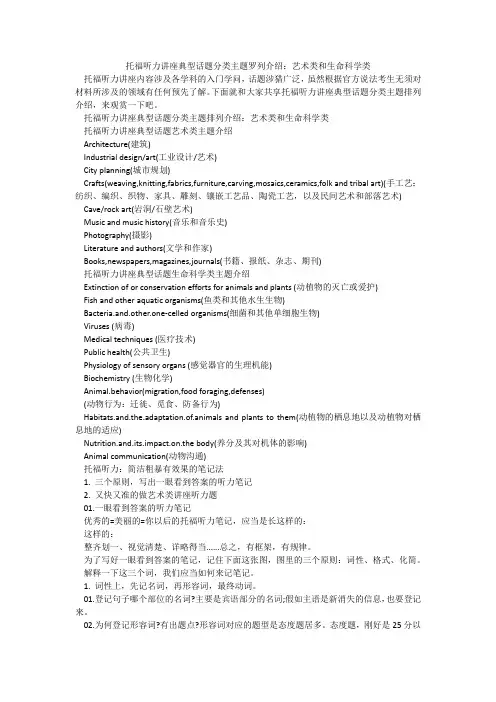
托福听力讲座典型话题分类主题罗列介绍:艺术类和生命科学类托福听力讲座内容涉及各学科的入门学问,话题涉猎广泛,虽然根据官方说法考生无须对材料所涉及的领域有任何预先了解。
下面就和大家共享托福听力讲座典型话题分类主题排列介绍,来观赏一下吧。
托福听力讲座典型话题分类主题排列介绍:艺术类和生命科学类托福听力讲座典型话题艺术类主题介绍Architecture(建筑)Industrial design/art(工业设计/艺术)City planning(城市规划)Crafts(weaving,knitting,fabrics,furniture,carving,mosaics,ceramics,folk and tribal art)(手工艺:纺织、编织、织物、家具、雕刻、镶嵌工艺品、陶瓷工艺,以及民间艺术和部落艺术) Cave/rock art(岩洞/石壁艺术)Music and music history(音乐和音乐史)Photography(摄影)Literature and authors(文学和作家)Books,newspapers,magazines,journals(书籍、报纸、杂志、期刊)托福听力讲座典型话题生命科学类主题介绍Extinction of or conservation efforts for animals and plants (动植物的灭亡或爱护)Fish and other aquatic organisms(鱼类和其他水生生物)Bacteria.and.other.one-celled organisms(细菌和其他单细胞生物)Viruses (病毒)Medical techniques (医疗技术)Public health(公共卫生)Physiology of sensory organs (感觉器官的生理机能)Biochemistry (生物化学)Animal.behavior(migration,food foraging,defenses)(动物行为:迁徙、觅食、防备行为)Habitats.and.the.adaptation.of.animals and plants to them(动植物的栖息地以及动植物对栖息地的适应)Nutrition.and.its.impact.on.the body(养分及其对机体的影响)Animal communication(动物沟通)托福听力:简洁粗暴有效果的笔记法1. 三个原则,写出一眼看到答案的听力笔记2. 又快又准的做艺术类讲座听力题01.一眼看到答案的听力笔记优秀的=美丽的=你以后的托福听力笔记,应当是长这样的:这样的:整齐划一、视觉清楚、详略得当......总之,有框架,有规律。
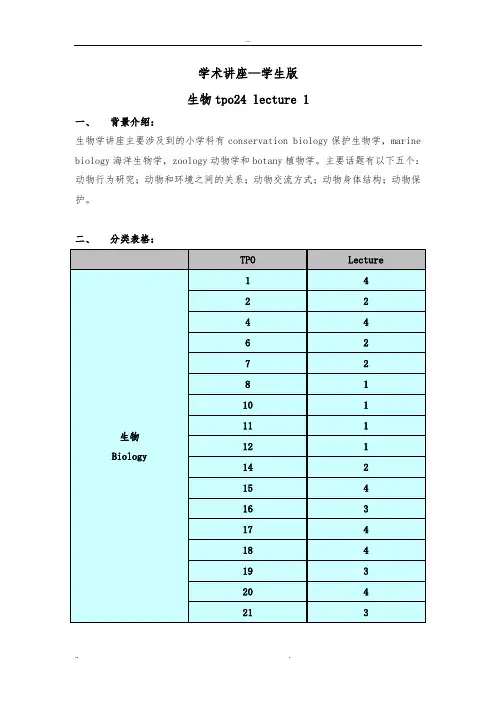
学术讲座—学生版生物tpo24 lecture 1一、背景介绍:生物学讲座主要涉及到的小学科有conservation biology保护生物学,marine biology海洋生物学,zoology动物学和botany植物学。
主要话题有以下五个:动物行为研究;动物和环境之间的关系;动物交流方式;动物身体结构;动物保护。
二、分类表格:三、各分类常见逻辑结构:生物类考点分析分类部位及特征用途(植物)习性(动物)栖息地繁殖与其他生物的关系生存状况相关研究生物类常见逻辑结构在课堂演讲中,教授常常会就某一生物现象或者生物特征进行讲解,并举出相应的例子进行证明,期间往往会有老师的自问自答和已经和学生之间的讨论。
四、十三大原则中这节课会用到的原则+举例1. 开头原则:2. 问答原则3. 举例原则4. 强调原则(语义的强调):5. 结尾原则五、本次课可能用到的笔记法1. 笔记热身1)中文简写2)符号2. TPO1 Conversation1 笔记六、词汇,短语及句式1)生物类场景常用的词汇2)本次课常用词汇3)本次课常用短语及句式:七、文章框架分析1. Crocodile: a predator that hasn't evolved much in the last seventy million years2. The functions of American alligators’ vocalization: ①To threaten other males ② To attract matesThe functions of baby crocodiles’vocalization: ①getting attention ②letting others know you are distressed:baby crocodiles。
The relationship of vocalization between crocodiles and mammals3. The functions of mother crocodiles’ vocalization: to ensure their babies follow her.八、听力文本Narrator:Listen to part of a lecture in a Biology class.Professor: OK. For today, let's look at a reptile, a predator that hasn't evolved much in the last seventy million years. No discussion of reptiles would be complete without some mention of crocodiles.(教授开门见山提出讲座的主旨:a predator--crocodiles,其中today, let’s look at...就是主旨句的提示句型。
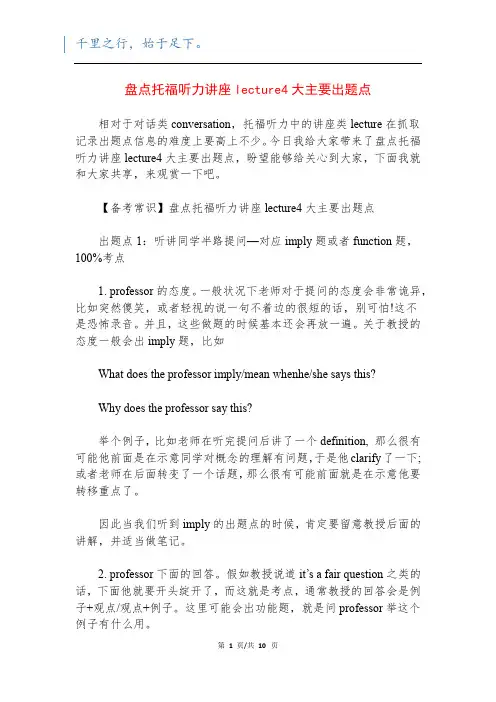
盘点托福听力讲座lecture4大主要出题点相对于对话类conversation,托福听力中的讲座类lecture在抓取记录出题点信息的难度上要高上不少。
今日我给大家带来了盘点托福听力讲座lecture4大主要出题点,盼望能够给关心到大家,下面我就和大家共享,来观赏一下吧。
【备考常识】盘点托福听力讲座lecture4大主要出题点出题点1:听讲同学半路提问—对应imply题或者function题,100%考点1. professor的态度。
一般状况下老师对于提问的态度会非常诡异,比如突然傻笑,或者轻视的说一句不着边的很短的话,别可怕!这不是恐怖录音。
并且,这些做题的时候基本还会再放一遍。
关于教授的态度一般会出imply题,比如What does the professor imply/mean whenhe/she says this?Why does the professor say this?举个例子,比如老师在听完提问后讲了一个definition, 那么很有可能他前面是在示意同学对概念的理解有问题,于是他clarify了一下;或者老师在后面转变了一个话题,那么很有可能前面就是在示意他要转移重点了。
因此当我们听到imply的出题点的时候,肯定要留意教授后面的讲解,并适当做笔记。
2. professor下面的回答。
假如教授说道it’s a fair question之类的话,下面他就要开头绽开了,而这就是考点,通常教授的回答会是例子+观点/观点+例子。
这里可能会出功能题,就是问professor举这个例子有什么用。
出题点2:professor举的例子—对应功能题Professor举例子的时候肯定要把例子登记来,并且要知道他在例子之前说了什么,由于例子论证的一般都是前面的观点。
举例子的关键词有for example, for instance等,基本就是摆好架子要开说了,听到这些短语就抄起笔/竖起耳朵抓紧听吧。
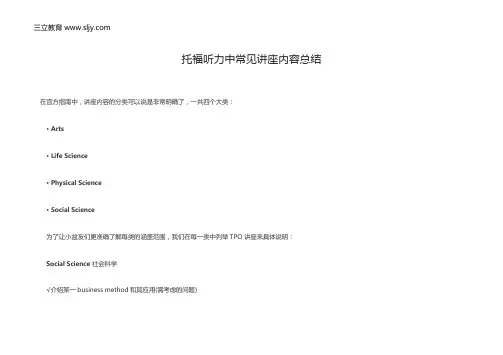
托福听力中常见讲座内容总结在官方指南中,讲座内容的分类可以说是非常明确了,一共四个大类:· Arts· Life Science· Physical Science· Social Science为了让小盆友们更准确了解每类的涵盖范围,我们在每一类中列举TPO 讲座来具体说明:Social Science 社会科学√介绍某一business method和其应用(需考虑的问题)√介绍一种心理现象和产生的原因一种心理现象及其合理解释TPO10 L4/Psychology·提出possible explanations for childhood amnesia(健忘症)·详细解释其中一种explanation - Piaget’s theory of cognitive development - young children can't symbolically represent objects and events 即是因为没有语言能力·介绍 memory tests, which proves that young children can recall,又介绍有实验证明recall和language development之间没有关系·最后提出childhood amnesia真正的原因是 the rate of forgetting介绍一种marketing方法及其使用方法TPO26L1/Advertising·提出green marketing 概念· green marketing 也要遵循传统marketing 的方法·举例 one green marketing campaign 先失败后成功的原因·总结 green marketing should be valid on all dimensions 即 extreme green company 介绍一种advertising plan 及其考虑方面TPO11L4/Business·提出要有systematic advertising plan·分别列举Four Ms - Market, Media, Money, Message 重要性及考虑方法·举例Soup Shop, 用Four Ms来进行评价Arts 人文科学√介绍某一artist和其作品特点/social influence(常常涉及与其他艺术家比较)√介绍某一时期某种art的发展历史(总结TPO发现往往强调women的改变或影响)介绍一位artist 及其作品TPO1L1/Contemporary Art·介绍Rose Frantzen及其风格Realistic Impressionism·分别列举可以体现Frantzen Realistic/Impressionism的作品·结尾mention Rose Frantzen的life story介绍art world of Paris in the late 19th centuryTPO8 L2/Art History · art classes available for women· good competition in class for women· better achievements of women insalon介绍一位film-makerPL及其作品特点TPO3L2/Film History· unique hybrid of styles· underwater film-making,focusing on the aquatic animal world·学生提出另一个film-maker 也focus underwater, 老师比较两个maker的difference·学生提出问题,为什么PL不为人所知,老师解答原因介绍musician 在movie 中的工作和其发展TPO22L4/Music History·教授提出musician 开始在movie theater 工作·教授提出 music in movie 不一定和电影本身correspond, 并进一步解释 music were not specially written for a particular movie · new sound systems 出现之后给这些movie musician 造成的影响介绍piano 对European music 和society的影响TPO16 L2/Music History·介绍percussive effect of little hammers 对pianist/composer/performer的影响· piano 的social impact (women)Life Science 生命科学√介绍one species的特点/special behavior以及形成的原因√比较两种species的不同特点/behavior以及产生difference的原因√介绍关于某种species演变的证据(中间会有inconsistency)比较two marmot species的不同behavior TPO1L4/Biology·教授提出marmot的特点,并指出两种species - eastern/Olympic marmot·介绍eastern marmot的行为,并解释growing season·教授提出两种species 的不同行为,eastern marmot don't need to stay as family to survive ·最后用Olympic marmot的行为进行对比介绍one species of oak 的特点及造成的原因TPO6L2/Biology·教授提出Nightcap Oak的两个特点:rare and the origin of trees·教授提出问题:rare和reproduce 的原因·学生回答是seed dispersal,教授肯定·教授进一步指出原因是 Nightcap Oak 无法spread well,但是good at maintaining itself 介绍some fossil discoveries of whales evolution TPO10 L1/Marine Biology·教授提出whales 如何从land creature演变到ocean dweller 还是mystery·教授举了3个最近的fossil discovery, 但并不能completely solve the mystery·又列举了DNA证明 whales是hippopotamus的后代,和之前的evidence是矛盾的·最后又列举了一个DNA research中体现的矛盾介绍animals怎样make decisions evolution TPO16 L3/ Biology·教授提出 behavior是a matter of natural selection·列举foraging behavior among beavers, 描述beaver在选择过程中的two critical issues ·最后指出不是conscious behavior, 而是the behavior has evolved over time。
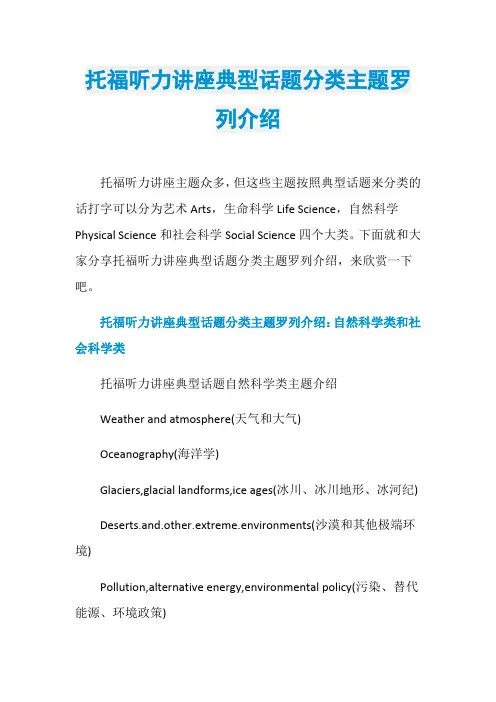
托福听力讲座典型话题分类主题罗列介绍托福听力讲座主题众多,但这些主题按照典型话题来分类的话打字可以分为艺术Arts,生命科学Life Science,自然科学Physical Science和社会科学Social Science四个大类。
下面就和大家分享托福听力讲座典型话题分类主题罗列介绍,来欣赏一下吧。
托福听力讲座典型话题分类主题罗列介绍:自然科学类和社会科学类托福听力讲座典型话题自然科学类主题介绍Weather and atmosphere(天气和大气)Oceanography(海洋学)Glaciers,glacial landforms,ice ages(冰川、冰川地形、冰河纪) Deserts.and.other.extreme.environments(沙漠和其他极端环境)Pollution,alternative energy,environmental policy(污染、替代能源、环境政策)Other planetsatmospheres(其他星球的环境)Astronomy and cosmology(天文学和宇宙学)Properties of light,optics(光的特性、光学)Properties of sound(声的特性)Electromagnetic radiation(电磁辐射)Particle physics(粒子物理学)Technology of TV,radio,radar(电视、广播和雷达技术)Chemistry of inorganic things(无机物的化学性质)Computer science(计算机科学)Seismology..(plate.structure,earthquakes,tectonics,continental.drift ,structure.of.volcanoes)(地震学:板块结构、地震、构造地质学、大陆漂移、火山结构)托福听力讲座典型话题社会科学类主题介绍Anthropology of nonindustrialized civilizations (非工业化文明社会的人类学)Early writing systems (早期文字系统)Historical linguistics (历史语言学)Business,management,marketing,accounting (商业、管理、市场、会计)TV/radio as mass communication (作为大众传媒的电视/电台)Social.behavior.of.groups,community.dynamics,communal beha-vior(群体的社会行为、群落动态、集群行为)Child development(儿童发展)Education(教育)Modern.history.(including.the.history.of.urbanization.and industrialization and their economic and social effects)(现代历史,包括城市化的历史及其带来的经济和社会影响)托福听力:对话conversation出题思路讲解托福听力对话类套路解析:去找老师的学生都是好学生在托福听力的对话中,好学生不一定成绩好,但是一定态度好,即:听老师话,乖乖跟着老师的建议走,老师让交论文的design plan/proposal就会认真去写,老师让把论文重新修改也会一边问一边改,老师说什么就是什么,老师最大,永远向老师低头。
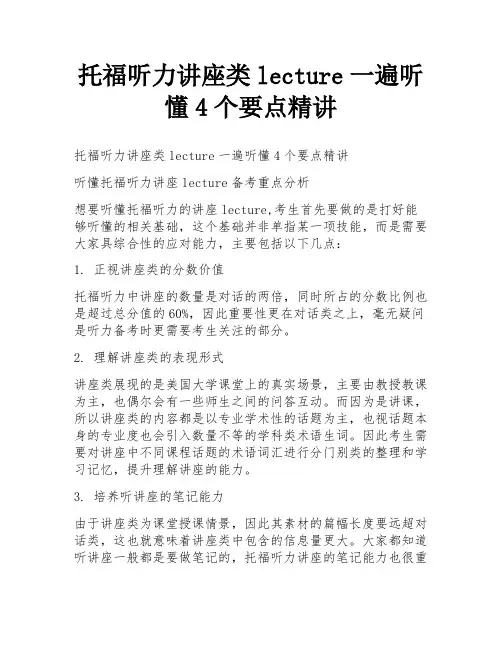
托福听力讲座类lecture一遍听懂4个要点精讲托福听力讲座类lecture一遍听懂4个要点精讲听懂托福听力讲座lecture备考重点分析想要听懂托福听力的讲座lecture,考生首先要做的是打好能够听懂的相关基础,这个基础并非单指某一项技能,而是需要大家具综合性的应对能力,主要包括以下几点:1. 正视讲座类的分数价值托福听力中讲座的数量是对话的两倍,同时所占的分数比例也是超过总分值的60%,因此重要性更在对话类之上,毫无疑问是听力备考时更需要考生关注的部分。
2. 理解讲座类的表现形式讲座类展现的是美国大学课堂上的真实场景,主要由教授教课为主,也偶尔会有一些师生之间的问答互动。
而因为是讲课,所以讲座类的内容都是以专业学术性的话题为主,也视话题本身的专业度也会引入数量不等的学科类术语生词。
因此考生需要对讲座中不同课程话题的术语词汇进行分门别类的整理和学习记忆,提升理解讲座的能力。
3. 培养听讲座的笔记能力由于讲座类为课堂授课情景,因此其素材的篇幅长度要远超对话类,这也就意味着讲座类中包含的信息量更大。
大家都知道听讲座一般都是要做笔记的,托福听力讲座的笔记能力也很重要。
大家在备考时需注意培养边听边记的做笔记能力和习惯,以避免遗漏可能成为出题点的细节信息。
托福听力讲座一遍听懂要点讲解想要做到托福听力讲座一遍就能听懂,下面这4个要点大家需要做好:1. 听懂开头抓主题首先,大家需要在开头部分就集中精力听懂这段课程的主讲话题。
这一点并不难做到,因为一般来说大家听讲座刚开始注意力都是相对集中的。
而讲座类听力在正式开始前也会给出一个简单的提示介绍告诉你这篇听力素材的大致学科方向。
同时讲座类听力基本上也都是开门见山上来就会讲主题,所以听懂开头抓住主题并非难事。
2. 主动预测后续内容抓住主题不难,但抓住主题之后还需要做什么就很关键了。
不少同学听不懂讲座内容,问题在于缺乏积极主动性,始终在被动接受信息听到什么记什么,而没有主动去思考后面可能会讲什么。
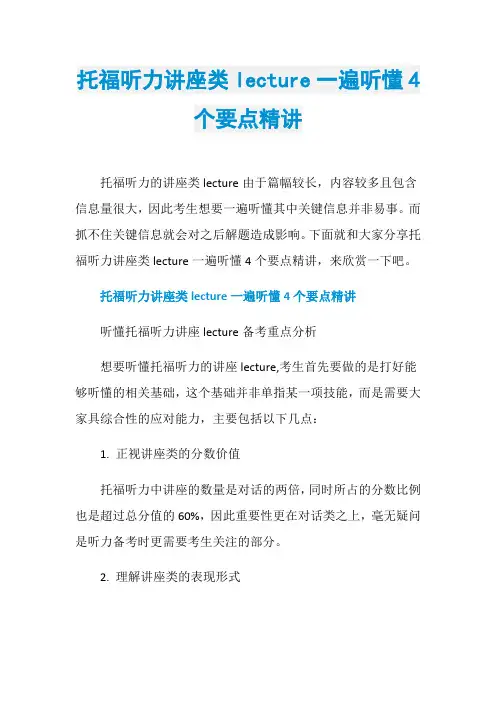
托福听力讲座类lecture一遍听懂4个要点精讲托福听力的讲座类lecture由于篇幅较长,内容较多且包含信息量很大,因此考生想要一遍听懂其中关键信息并非易事。
而抓不住关键信息就会对之后解题造成影响。
下面就和大家分享托福听力讲座类lecture一遍听懂4个要点精讲,来欣赏一下吧。
托福听力讲座类lecture一遍听懂4个要点精讲听懂托福听力讲座lecture备考重点分析想要听懂托福听力的讲座lecture,考生首先要做的是打好能够听懂的相关基础,这个基础并非单指某一项技能,而是需要大家具综合性的应对能力,主要包括以下几点:1. 正视讲座类的分数价值托福听力中讲座的数量是对话的两倍,同时所占的分数比例也是超过总分值的60%,因此重要性更在对话类之上,毫无疑问是听力备考时更需要考生关注的部分。
2. 理解讲座类的表现形式讲座类展现的是美国大学课堂上的真实场景,主要由教授教课为主,也偶尔会有一些师生之间的问答互动。
而因为是讲课,所以讲座类的内容都是以专业学术性的话题为主,也视话题本身的专业度也会引入数量不等的学科类术语生词。
因此考生需要对讲座中不同课程话题的术语词汇进行分门别类的整理和学习记忆,提升理解讲座的能力。
3. 培养听讲座的笔记能力由于讲座类为课堂授课情景,因此其素材的篇幅长度要远超对话类,这也就意味着讲座类中包含的信息量更大。
大家都知道听讲座一般都是要做笔记的,托福听力讲座的笔记能力也很重要。
大家在备考时需注意培养边听边记的做笔记能力和习惯,以避免遗漏可能成为出题点的细节信息。
托福听力讲座一遍听懂要点讲解想要做到托福听力讲座一遍就能听懂,下面这4个要点大家需要做好:1. 听懂开头抓主题首先,大家需要在开头部分就集中精力听懂这段课程的主讲话题。
这一点并不难做到,因为一般来说大家听讲座刚开始注意力都是相对集中的。
而讲座类听力在正式开始前也会给出一个简单的提示介绍告诉你这篇听力素材的大致学科方向。
同时讲座类听力基本上也都是开门见山上来就会讲主题,所以听懂开头抓住主题并非难事。
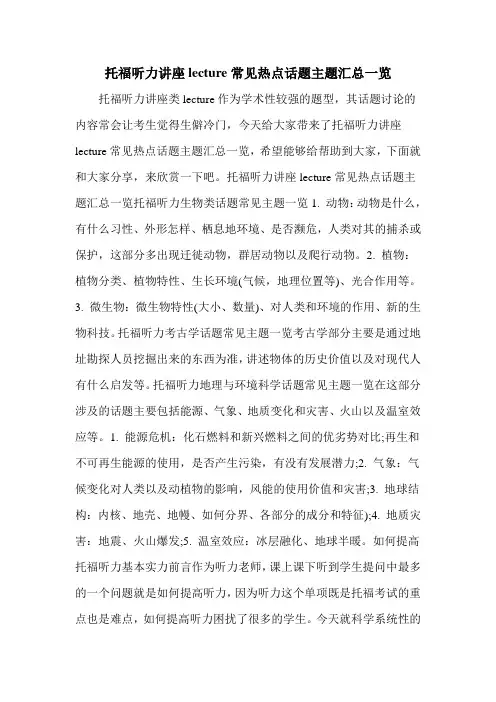
托福听力讲座lecture常见热点话题主题汇总一览托福听力讲座类lecture作为学术性较强的题型,其话题讨论的内容常会让考生觉得生僻冷门,今天给大家带来了托福听力讲座lecture常见热点话题主题汇总一览,希望能够给帮助到大家,下面就和大家分享,来欣赏一下吧。
托福听力讲座lecture常见热点话题主题汇总一览托福听力生物类话题常见主题一览1. 动物:动物是什么,有什么习性、外形怎样、栖息地环境、是否濒危,人类对其的捕杀或保护,这部分多出现迁徙动物,群居动物以及爬行动物。
2. 植物:植物分类、植物特性、生长环境(气候,地理位置等)、光合作用等。
3. 微生物:微生物特性(大小、数量)、对人类和环境的作用、新的生物科技。
托福听力考古学话题常见主题一览考古学部分主要是通过地址勘探人员挖掘出来的东西为准,讲述物体的历史价值以及对现代人有什么启发等。
托福听力地理与环境科学话题常见主题一览在这部分涉及的话题主要包括能源、气象、地质变化和灾害、火山以及温室效应等。
1. 能源危机:化石燃料和新兴燃料之间的优劣势对比;再生和不可再生能源的使用,是否产生污染,有没有发展潜力;2. 气象:气候变化对人类以及动植物的影响,风能的使用价值和灾害;3. 地球结构:内核、地壳、地幔、如何分界、各部分的成分和特征);4. 地质灾害:地震、火山爆发;5. 温室效应:冰层融化、地球半暖。
如何提高托福听力基本实力前言作为听力老师,课上课下听到学生提问中最多的一个问题就是如何提高听力,因为听力这个单项既是托福考试的重点也是难点,如何提高听力困扰了很多的学生。
今天就科学系统性的分析如何提高听力。
做听力题的过程要弄懂如何提高听力,首先要知道的是在做听力题的过程中涉及到哪些环节和每个环节需要什么样的能力要求,如下图所示,做听力题的过程分为下面的三个步骤。
在这三个步骤中,编码等于听的过程;存储等于记笔记的过程;最后提取是做题的过程。
但是细分又可以分为如下几点。
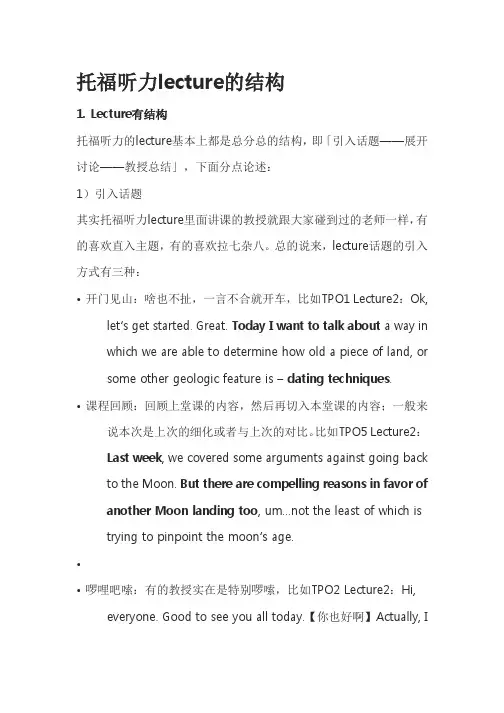
托福听力lecture的结构1. Lecture有结构托福听力的lecture基本上都是总分总的结构,即「引入话题——展开讨论——教授总结」,下面分点论述:1)引入话题其实托福听力lecture里面讲课的教授就跟大家碰到过的老师一样,有的喜欢直入主题,有的喜欢拉七杂八。
总的说来,lecture话题的引入方式有三种:•开门见山:啥也不扯,一言不合就开车,比如TPO1 Lecture2:Ok, let’s get started. Great. Today I want to talk about a way in which we are able to determine how old a piece of land, or some other geologic feature is –dating techniques.•课程回顾:回顾上堂课的内容,然后再切入本堂课的内容;一般来说本次是上次的细化或者与上次的对比。
比如TPO5 Lecture2:Last week, we covered some arguments against going back to the Moon. But there are compelling reasons in favor of another Moon landing too, um…not the least of which istrying to pinpoint the moon’s age.••啰哩吧嗦:有的教授实在是特别啰嗦,比如TPO2 Lecture2:Hi, everyone. Good to see you all today.【你也好啊】Actually, Iexpected the population to be a lot lower today. It typically runs between 50 and 60 percent on the day the researchpaper is due.【来的人多不好么,说明你受欢迎啊】Um, I was hoping to have your exams back today【啊,要放榜啦?】, but, uh, the situation was that I went away for the weekend, and I was supposed to get in yesterday at five, and Iexpected to fully complete all the exams by midnight or so, which is the time that I usually go to bed, but my flight was delayed, and I ended up not getting in until one o’clock in the morning【你飞机晚点关我什么事啊?】. Anyway, I’ll do my best to have them finished by the next time we meet【开始上课吧,please】. OK. In the last class, we started talking about...【终于开始了…】不论是用哪一种引入方式,话题总是要出来的。
托福听力对话讲座3大类场景话题分类汇总托福听力中无论是对话类conversation 还是讲座类lecture,一旦确定了场景,那么之后会出现哪些话题都有明确的对应关系和套路规律。
考生如果能够掌握这些规律,就能更为快速准确地理解听力内容把握关键信息。
下面小编就来为大家汇总托福听力对话和讲座的3 大类场景话题。
托福听力对话讲座3大类场景话题分类汇总托福听力对话类场景:学校生活这类话题主要出现在听力对话中。
对话中有一个套路就是,在对话双方见面的时候,其中一个人A 会表现或者提出自己的一个问题,然后两个人针对这个问题进行讨论。
之后,另外一个人 B 会给 A 提出几条建议,然后A 从中选择一个建议。
细化学校生活的场景可以分成以下五个方面:1. 食堂场景:对话双方讨论饭菜好不好吃、食堂的优惠政策、卫生安全等话题 ;2. 宿舍场景:宿舍的安排、学生校外租房、房间设施问题、室友之间相处问题 ;3. 图书馆场景:找不到想借的书、还书过期、图书馆准备考试、准备论文 ;4. 假期场景:假期去哪玩、回忆假期去过哪、有什么好玩的 ;5. 办公室场景:请假、延期交作业、论文准备、选课。
托福听力对话类场景:学校部门1. 注册:开学注册程序问题、选课选不上、关于缴费使用现金还是银行卡 ;2. 维修部:教室的桌椅损坏、宿舍的物品损坏 ( 灯、桌椅、门 ) 、协调修理时间 ;3. 勤工俭学:兼职工作,主要涉及到工作和课程冲突,如何协调。
托福听力讲座类场景:课堂课程1. 老师上课开头方式:( 1 ) 直接引入式:今天要讲这部分内容是…… ; 或者我们要补充讲一些背景知识。
( 2 ) 课堂回顾式:回顾一下上次课讲的内容,然后接着上次的内容讲或者讲新的内容。
( 3 ) 直接说我们今天讲什么内容。
然后开始讲。
( 4 ) 今天是复习课,然后讲某某考试,复习跟考试有关的内容。
2. 老师下课结束方式:主要是回顾一下当次课的主要内容,然后,交待可课下或者课后的任务或者安排:( 1 ) 交待在具体之后什么时间要考试,题型学生复习 ;( 2 ) 根据本堂课的内容,布置作业,强调作业要求 ;( 3 ) 介绍一下下次课的安排和内容 ;( 4 ) 老师下节课请假,找代课老师或者别的安排。
托福听力对话讲座5大类必须记住信息汇总托福听力对话讲座5大类必须记住信息汇总1. 记main idea---Lecture听力篇首:listen to part of the lecture in the X.X.X class, the professor if talking about X.X.X.---Conversation前30秒的主旨---屏幕变化出现图文时记下关键信息2. 记detail (不是所有细节都需要记下)what、when、where、who、why、how3. 记语气词语气词是最容易错过的,因为它本身并没有太大的实质意义。
常见的语气词有:now, well, OK, so, let’s, and oh.听到now, well, OK, so, let’s,基本上代表着一个新的话题的开始,即话题转变。
这些词可以不记,但在听到的时候在笔记上划条横线。
这样笔记就显得很清楚,横线上下属于两个话题,在答题的时候可避免张冠李戴、盲目地把听到的词拿来做题。
And oh即教授在讲话的时候突然想到了某一点,并进行补充。
如果这所谓的“某一点”不是重要信息,教授没有刻意补充的必要,所以不能小看“and oh”的作用。
4. 记逻辑词把逻辑关系词分类,主要有因果、假设、转折、解释补充、同异分类。
由于中西方逻辑思维的差异,有同学对很多显而易见的信息并不敏感。
然而这些逻辑中常含考点。
表示因果的有:because, since, thus, which results in, so,lead to. 注意其中的因果逻辑,不可因果颠倒。
表示转折的有:but, however, in fact, actually. But之后很有可能出考点。
注意:“A...but B...”在这里B是重点。
而且涉及到态度问题的时候,美国人喜欢把褒义放在前面,所以一般情况下but后面是贬义。
A之前可能没有明显的暗示信息,所以A的内容容易被忽略。
托福听力讲座类3大高频话题分类主题归纳整理托福听力讲座类lecture作为学术性较强的题型,其话题争论的内容常会让考生觉得生僻冷门,有时甚至会由于缺乏相关背景学问而听不明白究竟在讲什么。
下面就和大家共享托福听力讲座类3大高频话题分类主题归纳整理,盼望能够关心到大家,来观赏一下吧。
托福听力讲座类3大高频话题分类主题归纳整理托福听力生物类话题常见主题一览1. 动物:动物是什么,有什么习性、形状怎样、栖息地环境、是否濒危,人类对其的捕杀或爱护,这部分多消失迁徙动物,群居动物以及爬行动物。
2. 植物:植物分类、植物特性、生长环境(气候,地理位置等)、光合作用等。
3. 微生物:微生物特性(大小、数量)、对人类和环境的作用、新的生物科技。
托福听力考古学话题常见主题一览考古学部分主要是通过地址勘探人员挖掘出来的东西为准,叙述物体的历史价值以及对现代人有什么启发等。
托福听力地理与环境科学话题常见主题一览在这部分涉及的话题主要包括能源、气象、地质变化和灾难、火山以及温室效应等。
1. 能源危机:化石燃料和新兴燃料之间的优劣势对比;再生和不行再生能源的使用,是否产生污染,有没有进展潜力;2. 气象:气候变化对人类以及动植物的影响,风能的使用价值和灾难;3. 地球结构:内核、地壳、地幔、如何分界、各部分的成分和特征);4. 地质灾难:地震、火山爆发;5. 温室效应:冰层溶化、地球半暖。
新托福听力背景材料之黑洞所谓“黑洞”,就是这样一种天体:它的引力场是如此之强,就连光也不能逃脱出来。
依据广义相对论,引力场将使时空弯曲。
当恒星的体积很大时,它的引力场对时空几乎没什幺影响,从恒星表面上某一点发的光可以朝任何方向沿直线射出。
而恒星的半径越小,它对四周的时空弯曲作用就越大,朝某些角度发出的光就将沿弯曲空间返回恒星表面。
等恒星的半径小到一特定值(天文学上叫“史瓦西半径”)时,就连垂直表面放射的光都被捕获了。
到这时,恒星就变成了黑洞。
学术讲座—学生版生物tpo24 lecture 1一、背景介绍:生物学讲座主要涉及到的小学科有conservation biology保护生物学,marine biology海洋生物学,zoology动物学和botany植物学。
主要话题有以下五个:动物行为研究;动物和环境之间的关系;动物交流方式;动物身体结构;动物保护。
二、分类表格:三、各分类常见逻辑结构:生物类考点分析分类部位及特征用途(植物)习性(动物)栖息地繁殖与其他生物的关系生存状况相关研究生物类常见逻辑结构在课堂演讲中,教授常常会就某一生物现象或者生物特征进行讲解,并举出相应的例子进行证明,期间往往会有老师的自问自答和已经和学生之间的讨论。
四、十三大原则中这节课会用到的原则+举例1. 开头原则:2. 问答原则3. 举例原则4. 强调原则(语义的强调):5. 结尾原则五、本次课可能用到的笔记法1. 笔记热身1)中文简写2)符号2. TPO1 Conversation1 笔记六、词汇,短语及句式1)生物类场景常用的词汇2)本次课常用词汇3)本次课常用短语及句式:七、文章框架分析1. Crocodile: a predator that hasn't evolved much in the last seventy million years2. The functions of American alligators’ vocalization: ①To threaten other males ②To attract matesThe functions of baby crocodiles’vocalization: ①getting attention ②letting others know you are distressed:baby crocodiles。
The relationship of vocalization between crocodiles and mammals3. The functions of mother crocodiles’ vocalization: to ensure their babies follow her.八、听力文本Narrator:Listen to part of a lecture in a Biology class.Professor: OK. For today, let's look at a reptile, a predator that hasn't evolved muchin the last seventy million years. No discussion of reptiles would be complete without some mention of crocodiles.(教授开门见山提出讲座的主旨:a predator--crocodiles,其中today, let’s look at...就是主旨句的提示句型。
托福听力讲座lecture题型基础常识考点细节汇总讲解托福听力讲座lecture题型基础常识考点细节汇总讲解托福听力讲座类常考学科介绍托福听力讲座场景官方指南给出46个学科,实际上讲座内容多学科交叉出现的趋势越来越明显,艺术学、生命科学、天文学比、历史较常考。
新托福听力考试讲座部分则是还原真实上课情景,内容都牵涉到了各个学科,文理兼备。
如生物学、地理学、地质学、天文学、环境、文学、艺术、人类学等等。
托福听力讲座类需要背景知识积累吗?有关的这些内容中,有许多考生陌生的单词以及知识点,但考试根本不要求大家具备相应的背景知识,掌握了基本的单词和表达方式就能理解文章大意。
通常关键的术语都会在文章里用各种方式出现相应的解释。
但必须要注意在平日里积累更多方面的课外知识无疑能对做题会很有好处。
托福听力讲座类考查内容分析托福听力的讲座部分模拟的是在英语课堂上上课的情景,由于讲座经常涉及专业知识,所以难度比对话部分要大。
从考查内容来说,讲座部分的取材主要是来自于以下四类学科:文学艺术、生命科学、物理科学和社会科学。
考生可以通过分类练习大量真题来熟悉和掌握常考的话题,并从中学习与这四类学科常相关的高频词汇。
从内容来看,讲座大致有五种类型,分别是概念描述类、问题解答类、理论演变类、对比类和时间顺序类。
每一种类型都有各自的考查重点。
托福听力讲座类题型构成一览每一个讲座之后会出现六道题。
和对话部分一样,讲座部分通常会有一道题是主旨题,考查讲座的主要目的和内容;还有一道题是重听题,考查教授或者学生为什么说某一句话;中间的四道题通常为细节题,一般考查讲座中多次重复并解释的概念、教授举例的目的、教授和学生的互动以及教授的最后总结。
托福备考之独立写作满分范文task:Some people believe that university students should be required to attend classes. Others believe that going to classes should be optional for students. Which point of view do you agree with? Use specific reasons and details to explain your answer.托福备考之独立写作满分范文:Class Attendance Should Not Be CompulsoryIt is undoubtedly true that students should take their studies seriously. This means not only doing the required work, but also actively pursuing every opportunity to learn. So of course they should attend their classes to receive the maximum benefit. However, I do not believe that there is a need to make class attendance mandatory at the university level.By the time they reach university, students are no longer children. They are young adults and should be able to take responsibility for their actions. Attending their classes is of benefit to them, and while it may be tempting to skip them once in a while, it is not the responsible choice. Adults must be able to manage their time on their own and to make their own decisions. If a student misses too many classes and so does poorly in a course, he will have to accept the consequences and learn from his mistake. Finally, non-compulsory class attendance may not only lead to improvements in the students, but also in the teaching. Of course, every professor likes to see full attendance at his classes. If students are not coming to class, the professor should ask himself why. Perhaps the students do not understand the relevance of the material to their studies.In conclusion, I believe that class attendance should not berequired for university students. They should learn to make the right decisions for themselves, and this is one way to encourage the development of independence and responsibility.托福备考之独立写作满分范文task:Do you agree or disagree with the following statement? Television has destroyed communication among friends and family. Use specific reasons and examples to support your opinion.托福备考之独立写作满分范文:The Effects of Television on CommunicationThere is no doubt that television has greatly changed people’s lives. After its invention, it became an almost indispensable part of most households within the space of just a few years. Nowadays, many families have two or even three television sets so that every member of the family can watch what he wants whenever he wants. In my opinion, this has significantly reduced the amount of time that family and friends spend communicating with each other.Before the invention of television, people spent their leisure time in more active and social pursuits. They often played cards or other games, listened to the radio together or went out to see friends. But now television is widely available and it offers a variety of program choices that appeal to almost every interest. People no longer have to look to others for entertainment. Also, television can be like a sedative. Studies have shown that watching a great deal of television makes people more passive. Finally, people are simply watching increasing amounts of television. And with two or three TV sets in the house, there is no need for them to even watch it together.Although television has reduced the amount of time thatfamily and f riends spend together, it doesn’t have to be this way. People can make the choice to turn off the TV and do something more active. Or, if they really want to watch TV, they can find a thought-provoking program that they would all like to watch and discuss afterwards.托福备考之独立写作满分范文A job with more vacation time but a low salary is better than a job with a highsalary but less vacation time.是否同意低薪假期多的工作比高薪假期少的工作好?题目解析:对比类写法主题观点:支持高薪假期少的工作【思路拓展】1.工作是生活的重要部分,因此是幸福的源泉,很多人将自己的成就感和薪水的高低联系到一起。
托福听力lecture主要话题分类精讲托福听力lecture主要话题分类精讲,历史讲座哪些考点是高频?今天给大家带来了托福听力lecture主要话题分类精讲,希望能够帮助到大家,下面就和大家分享,来欣赏一下吧。
托福听力lecture主要话题分类精讲历史讲座哪些考点是高频?托福听力讲座类历史话题考点概述历史类场景往往和其他分支学科产生联系,具体可以从以下几个方面来考察:1. 国家政权或制度体制:如农业的产生,古埃及的女法老等。
2. 文化方面:如茶文化历史,戏剧的起源,考古方面等。
3. 著名历史人物:如爱默生,意大利画家等。
4. 其他话题:历史容易和其他学科产生交叉,如考古和艺术。
历史类的话题有一个很大的特点,就是专业词汇较多。
很多考生有这样一种感觉,就是好像听明白了一些,但一考到细节题就不知所措。
也就是说,历史类话题可能出现较多的专业词汇和细节,考生需谨慎。
下面我们就几个例子来仔细体会一下。
托福听力讲座类历史话题案例分析下面是一个历史话题的经典案例:听力原文:Well, their astronomers had discovered that at a certain time of year thebrightest star, Sirius, would disappear. Actually, it’d be hidden in the glareof the Sun. Even more significantly, the reappearance of Sirius would occuraround the same time as the Nile’s flooding. And this annual event is called aheliacal rising. The heliacal rising was a fair indicator of when the Nile wouldflood. The next new moon, after the heliacal rising of Sirius, which happened inthe last month of the calendar year, marked the New Year.Why was the helical rising if Sirius important to the Egyptians?Click on 2 answers.A. It helped determine the beginning of the New Year.B. It was used to calculate the length of the month.C. It marked the beginning of harvest time.D. It indicated when the Nile would flood.分析:此处考的是埃及的历法。
在这个节选原文中包含了Sirius(天狼星),heliacalrising(偕日升)等概念,比较难以理解,需要考生有较快的反应速度。
不少学员在遇到这类话题时会怀有抵触心态,大呼这种难度跟阅读都差不多了。
诚然专业度高理解困难,考生应该认识到一点:ETS的考察宗旨还是不变的——检验考生的瞬时理解能力和知识储备的快速激活。
在此,要做对这道双选题,要留心粗体信号词;还可以将辨音中听不懂的陌生词转化成抽象符号,搞清楚其作用即可。
可以看出,Nile和NewYear是关键词,故轻松选出AD。
下面再看一个例子:听力原文:Now for the taste... Now, this is a good point to mention one of the biggest myths about spices. It’s commonly said that medieval Europeans wantedspices to cover up the taste of spoiled meat. But this isn’t really true. Anyonewho had to worry about spoiled meat couldn’t afford spices in the first place.If you could afford spices, you could definitely afford fresh meat. We also haveevidence that various medieval markets employed a kind of police to make surethat people did not sell spoiled food, and if you were caught doing it, you weresubject to various fines, humiliating public punishments. So what actuallywastrue was this: In order to have meat for the winter, people would preserve it insalt, not a spice. Spices actually aren’t very effective as preservatives.What two factors explain why medieval Europeans did not use spices to coverthe taste of spoiled meat?Click on 2 answers.A. Fresh meat was less expensive than spices were.B. Spices were mainly used in incense and perfume.C. The sale of spoiled food was prohibited.D. Salt was cheaper than most spices were.分析:这里考察的是香料在历史上的角色。
背景知识:香料在中世纪的欧洲是非常名贵的东西,只有贵族皇族才能享用得到。
原因诸多,运输昂贵是其中之一。
考生若不熟悉spice这个单词,可以根据上下文猜测,此处很容易猜出。
在这里想强调一下myth的含义。
大多数考生对这个词的理解都存在误区。
实际上这个词只要考到,一般取“误解”这一含义,而非神话等义。
在这里是说,人们用香料腌制坏掉的食物这种理解是错误的,因为人们有钱买香料就有钱买鲜肉,前者的理解本身就有矛盾。
同时注意also这个重要并列词,后面引出第二个原因,所以选AC。
托福听力讲座类历史话题考点追踪从上面这个例子可以看出历史话题具有以下特点:1. 细节偏多:可能没有信号词引领,听时要聚精会神。
2. 信号词:信号词的形式多种多样,可能是单独的词组,也有可能是融汇在句子当中,要及时做好笔记。
3. 陌生概念:可先记下首字母,上下文一般会有定义解释或同义词。
也可以注意计算机屏幕的提示词是否为这个词。
关于托福听力讲座类历史话题的考点和出题思路就为大家分析介绍到这里,希望以上内容可以帮助各位考生更好地解答历史类题目拿到听力高分。
托福备考之听力记笔记的五大技巧1.记关键词所谓关键词,是指与听力中心内容有密切关系的词汇和短语,是考点的主要出处。
一般是实词,即名词,动词,形容词,副词,否定和数词。
抓住了听力中的关键词,整个文章的大意就呼之欲出了。
因此,记录关键词是最基本的方法。
至于找关键词的方法,我附上了听力十大原则的文件,这个方式无论记不记笔记都一样的。
2.记逻辑词和短语提示逻辑词和逻辑短语是连接一篇文章的筋骨和脉络。
外国人对于逻辑思维非常重视,托福中从阅读到作文无不体现出来这一点。
因此,听清楚逻辑词,记录下来,对于内容的之间的关系和顺序等的了解就容易了。
托福中出现的逻辑关系(Barron P75):Definition★Description and example★★Classification★Sequence★★★Comparision and contrast★★Cause and effect★★Problem and solutionPersuation and evaluation对于逻辑词和短语的总结,delta和barron上面都有提及,这里就不再累述了。
顺便说一点,拥有良好的逻辑意识和掌握相当的逻辑词和短语无论在分析阅读,听听力,说口语还是写作文的时候都是一个优势,能给评分教授一个清晰的条理。
还是那句话,你让教授爽,他就让你更爽!3.利用缩写,简写,逻辑符号,换词减少记录时间记笔记关键是速度。
新托福的语速还是跟老托差不多,比barron 的快。
因此,要懂得如何简化自己的笔记,同时让自己看得明白清楚。
缩写和符号是很好的方法。
我已经附上了自己总结的缩写和逻辑符号,大家可以下载。
同时,大家在准备过程中也可以按照自己的思路添加更多的缩写。
另外,换词也是一种很好的方法,在barron中专门有一章paraphasing的技巧训练,而阅读不是有换句子的题型吗?证明是托福要求掌握的能力之一。
在note taking中的换词,不需要改成复杂深奥的词语,恰恰相反。
举个例子:当你听到…opportunity…的时候,如果要写下来,那多麻烦啊,要考虑复杂的拼写。
但是如果你马上晓得改写成chance,那就节约了很多时间。
还有,没人说只能写英文啊!当你听到large,small的时候,你不觉得记上“大”“小”更快吗?所以当你发现某个词出现得比较常见但是又浪费时间去记录它的话,就可以利用换词解决。
如此类推,可以应用的地方还是很多的。
4.巧妙利用听力时的“空余时间”老师教的方法。
就是在教授说了一堆nonsense的时,或者两人对话时,非表达观点着说话时(例如口语第3,5题),利用“空余时间”来补全之前没有做好的笔记。
这一个方法同时提示我们,某个点如果没有记下来时,不要以放弃后面的内容为代价来花费时间记笔记,只要心里留个印象就可以了,等后面适当的时机再补上。
5. 利用清晰的结构减少查看笔记的时间记录笔记的最终目的是做题的需要。
因此,记录了笔记而自己都看不懂,或者花大量时间翻看笔记,都是得不偿失的做法。
特别是做口语笔记的时候,你的preparationtime是非常宝贵的。
因此,平时锻炼notetaking时,要注意有自己的结构。
例如是左右分别记主题和分论点?还是一行一行的记下来并做标注?例如在记录综合作文听力时,很多人习惯把草稿纸对折然后一边是reading的观点,另一边是lecture的观点。